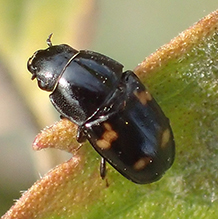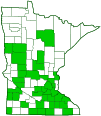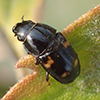four-spotted sap beetle
(Glischrochilus quadrisignatus)
Conservation • Description • Habitat • Ecology • Distribution • Taxonomy
Conservation Status |
|
|||||||
| IUCN Red List | not listed |
|||||||
| NatureServe | NNR - Unranked |
|||||||
| Minnesota | not listed |
|||||||
Description |
||
Four-spotted sap beetle, also called picnic beetle, is a common, small, sap-feeding beetle. It is native to North America. It occurs in the United States from Maine to northern Georgia, west to Washington and Oregon. It also occurs across southern Canada. It is common in Minnesota. It was introduced into Europe, where it was first found in 1948 in the area around Berlin, Germany. It has spread widely, and it now occurs from Ireland west to the Ural Mountains, from Scandinavia south to the Mediterranean Sea. Four-spotted sap beetle adults are active from April through September. They feed on decaying fruit, corn, dung, carrion, tree sap, and fungi. They have been found in tree wounds and under the bark of cherry trees. Though called sap beetles, they feed mostly on fruit that is damaged, overripe, or rotting. They are attracted to all decaying matter that emits ethanol. Once attracted to damaged or decomposing fruits and vegetables, they will also attack intact fruits and vegetables in the vicinity. They are an agricultural pest when they invade stored or hanging fruit and vegetables. They are also a nuisance to people who are picnicking or consuming beverages outdoors. This has inspired two of the beetle’s common names, picnic beetle and beer bug. Adults are black, shiny, and ⅛″ to ¼″ (4.0 to 7.0 mm) in length. The body is elongate-robust, oblong when viewed from above, and convex when viewed from the side or the front. The head is large and broad. The antennae have 11 segments. The last three segments are abruptly expanded into a distinct, ball-shaped club. The mouthparts are directed forward. The exoskeletal plate covering the thorax (pronotum) is wider than long. The margins are sharply and narrowly flattened and turned outward. The hardened wing covers (elytra) are short. They are not grooved. They appear cut off at the end, and they do not cover the last two segments of the abdomen. There are four large, irregular, brownish-yellow spots, two near the front margin and two beyond the middle. This is the feature that gives the beetle its common name. The front spots are farther apart – farther from the inner margin (suture) – than the rear spots. On the front spots, the outline in deeply notched. The last part of each leg (tarsus), corresponding to the foot, has five segments. |
||
Size |
||
Total length: ⅛″ to ¼″ (4.0 to 7.0 mm) |
||
Similar Species |
||
Habitat |
||
|
||
Ecology |
||
Season |
||
|
||
Behavior |
||
|
||
Life Cycle |
||
The female deposits eggs near but not on decomposing plant material that is buried in the ground or in contact with the ground and the soil is moist. Adults overwinter. |
||
Larva Food |
||
|
||
Adult Food |
||
Decaying fruit, corn, dung, carrion, tree sap, and fungi |
||
Distribution |
||||
|
Sources |
|||
| 1/5/2024 | ||||
Occurrence |
||||
Common |
||||
Taxonomy |
|||
Order |
Coleoptera (Beetles) | ||
Suborder |
Polyphaga (Water, Rove, Scarab, Long-horned, Leaf, and Snout Beetles) | ||
Infraorder |
Cucujiformia | ||
Superfamily |
Cucujoidea (sap, bark, and fungus beetles) | ||
Family |
Nitidulidae (sap-feeding beetles) | ||
Subfamily |
Cryptarchinae | ||
Genus |
Glischrochilus | ||
| Subgenus | Librodor | ||
Synonyms |
|||
Glischrochilus bipunctatus Glischrochilus bipustulutus Glischrochilus canadensis Glischrochilus sexpustulatus Glischrochilus similis Ips quadrisignatus Librodor quadrisignatus |
|||
Common Names |
|||
beer bug four-spot sap beetle four-spotted sap beetle fourspotted sapbeetle picnic beetle |
|||
Glossary
Elytra
The hardened or leathery forewings of beetles used to protect the fragile hindwings, which are used for flying. Singular: elytron.
Pronotum
The exoskeletal plate on the upper side of the first segment of the thorax of an insect.
Tarsus
On insects, the last two to five subdivisions of the leg, attached to the tibia; the foot. On spiders, the last segment of the leg. Plural: tarsi.
Visitor Photos |
|||||
Share your photo of this insect. |
|||||
| This button not working for you? Simply email us at info@MinnesotaSeasons.com. Attach one or more photos and, if you like, a caption. |
|||||
Babette Kis |
|||||
Glischrochilus quadrisignatus four spotted sap beetle Glischrochilus quadrisignatus, four spotted sap beetle, photographed on Barnes Prairie, Racine Co., WI on September 20, 2023. |
 |
||||
MinnesotaSeasons.com Photos |
|||||
|
|||||

Slideshows |
||

Visitor Videos |
|||
Share your video of this insect. |
|||
| This button not working for you? Simply email us at info@MinnesotaSeasons.com. Attach a video, a YouTube link, or a cloud storage link. |
|||
Other Videos |
|||
| Four-spotted Sap Beetle (Nitidulidae: Glischrochilus quadrisignatus) Carl Barrentine |
|||
About
Jul 25, 2010 Photographed at Grand Forks, North Dakota (25 July 2010). |
|||
| Glischrochilus quadrisignatus Les Leighton |
|||
About
May 11, 2012 Beer Beetle or Four-Spot Sap Beetle. I have heard that on a hot day, when you are out on the patio sipping a cold brew that "plop", one or two of these beetles are sure to take a dip in your beer. They are attracted to fermented drinks and rotting fruit. They are a small black flying beetle with four reddish-brown spots on their elytra ( hard wing covers ). Their antenna sport round disks at the tip. ( Glischrochilus quadrisignatus ) Vancouver BC May 11, 2012 approximate length 7 mm |
|||
| a Bug's Thoughts (Four-spotted Sap Beetle) Bug's Life Matters |
|||
About
Aug 2, 2021 Glischrochilus quadrisignatus, known generally as four-spotted sap beetle, is a species of sap-feeding beetle in the family Nitidulidae. Other common names include the beer bug and picnic beetle. It is found in North America and Europe. They do not bite or sting. In some instances, these beetles have caused severe damage by contaminating fruit and vegetables especially raspberries, tomatoes and corns. |
|||


Created: 1/5/2024
Last Updated:

